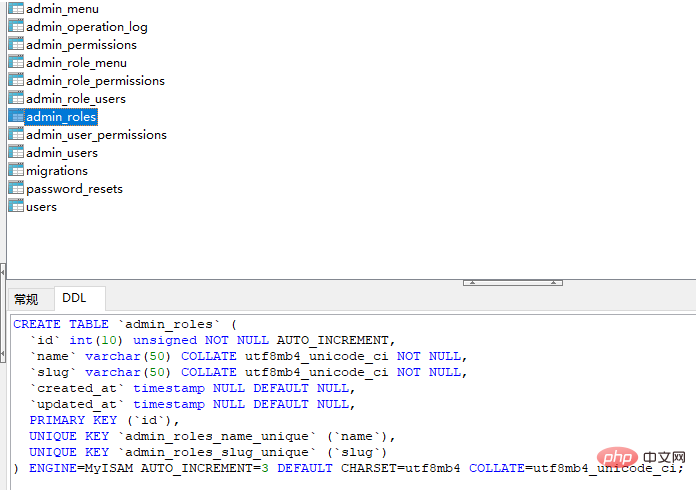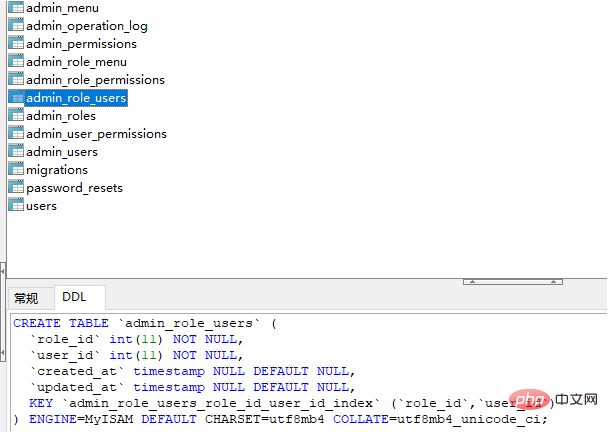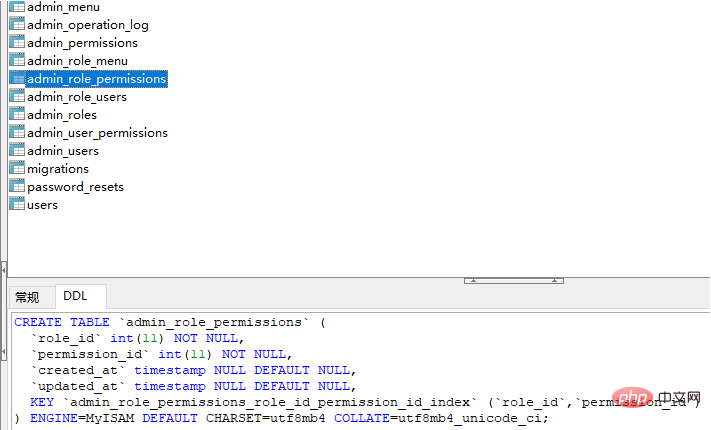laravel-admin permission management and implementation principles

We first use the laravel-admin background to implement a permission management
1. Add a user management permission

The identifier (slug) is a unique identifier used to mark permissions and is globally unique. The name (name) is the display name of this permission. It should be clear at a glance what this permission is used for.

2. Add a role

3. Create an administrator

#In this case, we have the user kaka, and then we log in, we only give The permissions of this kaka are managed by one user, so the setting is successful.

Analyze permission management
Implement permission management data table

1. Let’s take a look at the admin_user table first. This is just a table that simply stores background administrators.

#2. The following is our role table, that is, when we add roles in the laravel-admin background, it will be added to this table.

#3. Next comes the key point, our role user table.
We can see the role user table, which has a foreign key between the role id and the user id. This table connects the administrator and the role.

#4. The following is the permissions table, which stores all the permissions.

#5. Finally is our role permissions table.

Permission summary
The above shows you the specific table structure. In fact, this is not very complicated. We will briefly explain it. Let’s take a look:
First of all, why do we do permission management? We want different administrators to see different content.
1. Then the first table we need is the background administrator table admin_users. This table is only used to store the administrator account and password;
2. On a basic basis, that is our Role table admin_roles, the nature of this table is the same as the administrator table, and it is also used to store role information;
3. Then at this time, we need a table to associate our admin_users and admin_roles tables, that is admin_role_users, This table is just a middleware table. It only needs to store the corresponding relationship between administrators and roles;
4. After completing the above, we need a permission table admin_permissions. This table is to store our All permissions;
5. So do our permissions need to be associated with roles? Only in this way can users obtain the permissions they have from their roles, then a permission role table admin_role_permissions is needed.
python learning network, a large number of free laravel introductory tutorials, welcome to learn online!
The above is the detailed content of laravel-admin permission management and implementation principles. For more information, please follow other related articles on the PHP Chinese website!

Hot AI Tools

Undresser.AI Undress
AI-powered app for creating realistic nude photos

AI Clothes Remover
Online AI tool for removing clothes from photos.

Undress AI Tool
Undress images for free

Clothoff.io
AI clothes remover

Video Face Swap
Swap faces in any video effortlessly with our completely free AI face swap tool!

Hot Article

Hot Tools

Notepad++7.3.1
Easy-to-use and free code editor

SublimeText3 Chinese version
Chinese version, very easy to use

Zend Studio 13.0.1
Powerful PHP integrated development environment

Dreamweaver CS6
Visual web development tools

SublimeText3 Mac version
God-level code editing software (SublimeText3)

Hot Topics
 1386
1386
 52
52
 Laravel - Artisan Commands
Aug 27, 2024 am 10:51 AM
Laravel - Artisan Commands
Aug 27, 2024 am 10:51 AM
Laravel - Artisan Commands - Laravel 5.7 comes with new way of treating and testing new commands. It includes a new feature of testing artisan commands and the demonstration is mentioned below ?
 Laravel - Pagination Customizations
Aug 27, 2024 am 10:51 AM
Laravel - Pagination Customizations
Aug 27, 2024 am 10:51 AM
Laravel - Pagination Customizations - Laravel includes a feature of pagination which helps a user or a developer to include a pagination feature. Laravel paginator is integrated with the query builder and Eloquent ORM. The paginate method automatical
 How to get the return code when email sending fails in Laravel?
Apr 01, 2025 pm 02:45 PM
How to get the return code when email sending fails in Laravel?
Apr 01, 2025 pm 02:45 PM
Method for obtaining the return code when Laravel email sending fails. When using Laravel to develop applications, you often encounter situations where you need to send verification codes. And in reality...
 Laravel schedule task is not executed: What should I do if the task is not running after schedule: run command?
Mar 31, 2025 pm 11:24 PM
Laravel schedule task is not executed: What should I do if the task is not running after schedule: run command?
Mar 31, 2025 pm 11:24 PM
Laravel schedule task run unresponsive troubleshooting When using Laravel's schedule task scheduling, many developers will encounter this problem: schedule:run...
 In Laravel, how to deal with the situation where verification codes are failed to be sent by email?
Mar 31, 2025 pm 11:48 PM
In Laravel, how to deal with the situation where verification codes are failed to be sent by email?
Mar 31, 2025 pm 11:48 PM
The method of handling Laravel's email failure to send verification code is to use Laravel...
 How to implement the custom table function of clicking to add data in dcat admin?
Apr 01, 2025 am 07:09 AM
How to implement the custom table function of clicking to add data in dcat admin?
Apr 01, 2025 am 07:09 AM
How to implement the table function of custom click to add data in dcatadmin (laravel-admin) When using dcat...
 Laravel Redis connection sharing: Why does the select method affect other connections?
Apr 01, 2025 am 07:45 AM
Laravel Redis connection sharing: Why does the select method affect other connections?
Apr 01, 2025 am 07:45 AM
The impact of sharing of Redis connections in Laravel framework and select methods When using Laravel framework and Redis, developers may encounter a problem: through configuration...
 Laravel - Dump Server
Aug 27, 2024 am 10:51 AM
Laravel - Dump Server
Aug 27, 2024 am 10:51 AM
Laravel - Dump Server - Laravel dump server comes with the version of Laravel 5.7. The previous versions do not include any dump server. Dump server will be a development dependency in laravel/laravel composer file.




